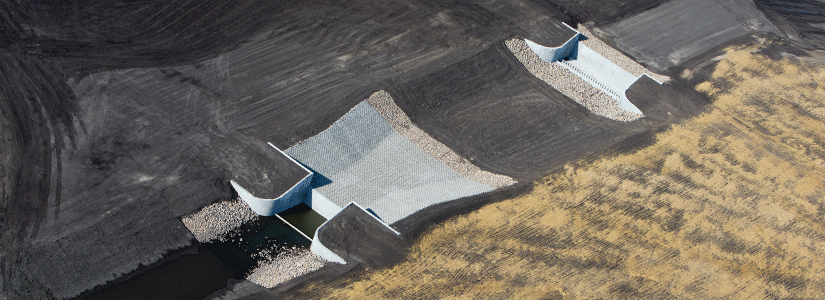
Isn’t “dry dam” an oxymoron?
With the recent completion of the $9 million Upper Maple River Dam and the work being done to improve dam safety in North Dakota and Minnesota, details of dam design might have you swimming with questions.
If you saw the recent news story about the Upper Maple River Dam, you know it is a “dry” dam. Located about six miles south of Hope, North Dakota, the Upper Maple River Dam will provide a significant benefit to local residents when it becomes operational in the spring of 2016 by reducing the flood risk to 22,365 acres of cropland and roadways, and reducing river peaks by as much as 92 percent along some corridors of the river.
Impressive, yes. But what about the word “dry”? What makes it a dry dam and why was dry the best solution for the situation?
A dry dam only holds water during flood events. After the flood waters recede, the storage area drains completely dry again. This is opposed to a “wet” dam, where at least some water is permanently stored in what is typically called a conservation pool. Often, wet dams are constructed for flood protection, power generation, water supply and/or recreation. Examples of wet dams include the Hoover Dam and, more locally, the Orwell and Byllesby Dams in Minnesota.
There were five main benefits to making the Upper Maple River Dam a dry dam:
More flood storage
Because a dry dam drains completely, it has more capacity. For example, the Upper Maple River Dam has a full 9,950 acre-feet of storage at the start of each flood event.
Usability of acreage
Because the storage area is dry except during a flood event, the acreage has the same utility it had prior to the dam installation. For the Upper Maple River Dam, the 925 acres of land reserved for pooling is not taken out of production. It’s usable and valuable crop and pasture land.
Permitting
A dry dam is often less expensive and easier to get permits, easements and right-of-way. Wet dams often create obstructions for passage of fish and other aquatic species. This can translate into difficulties obtaining necessary environmental approvals and permits. Many states, including Minnesota, have been making an effort to remove many existing on-channel wet dams to restore river connectivity. Approving new structures runs counter to that goal.
Fish and aquatic species
On-channel dry dams are built to allow fish and other aquatic species to swim through a pipe and get from one side of the dam to the other when low water conditions are present. This is not possible in a permanent pool, at least not without added mitigation measures that can bring unwanted complexities and costs.
Sediment maintenance
Dry dams can more easily handle sediment. They can be cleared out and maintained during the dry season. A wet dam would require expensive cleaning methods.
Have more questions about on- and off-channel wet and dry dams? Visit with our Water Resources professionals Dec. 9-10 at the Best Western Ramkota Hotel in Bismarck!